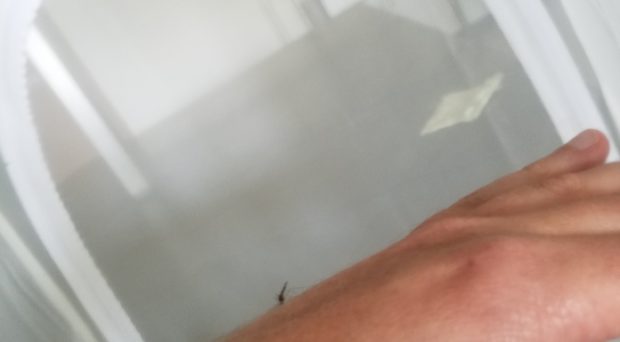
On this Sunday, August 20, World Mosquito Day was commemorated, remembering and considering the importance of this most dangerous animal of the world. Mosquitoes are notoriously difficult to control. One factor in this difficulty is the abundance of locations of standing water where they can breed, some of which are hard to detect or impossible to eliminate, ranging from backyard ponds and forgotten buckets and toys to sludge ponds and swales. Ideally, we could just tell the potential of these breeding sites to produce mosquitoes by looking at them, or perhaps measuring the water quality and nutrient levels in these breeding sites. Unfortunately, our understanding of the nutritional requirements of mosquito larvae are less than what one would expect. We do know that some mosquitoes (e.g. Culex pipiens) do require large amounts of nutrients, such as faeces, while other mosquitoes (e.g. Aedes aegypti) can successfully develop in the presence of seemingly minute resources (e.g. flower pot). In adult mosquitoes, we have a fairly good understanding of the importance of macronutrients derived from flower nectar and bloodmeal for both survival and reproduction. These issues are becoming personally important for my lab as I’m attempting to start a mosquito colony from mosquitoes collected in the field at Turnbull National Wildlife Refuge.
My prior readings and experience seeing other mosquito colonies suggested that all my mosquitoes need is sugar-water to survive and my blood in order to reproduce, providing macronutrients, such as carbohydrates and fatty acids. However, a recent paper by Rivera-Perez et al., which reviews the importance of micronutrients for the physiology of mosquitoes, suggested to me that my assumptions might be hopelessly naïve. Micronutrients, or non-energetic nutrients (NENs), which include amino acids, vitamins, salts, metals, and sterols, are all essential for the physiology and behavior of mosquitoes, as well as their immunity and vector competence. In nature, both male and female mosquitoes would consume floral nectar and honeydew, which are complex mixtures of chemicals, including amino acids, proteins, lipids, antioxidants, alkaloids, vitamins, organic acids, allantoin and allantoic acid, dextrins, and minerals, besides the sucrose that is in my sugar-water. While all blood meals provide amino acids, cholesterol, lipids and metals, not all blood is the same quality for mosquitoes. In particular, the amino acid isoleucine plays a critical role in female mosquito oogenesis – human blood is severely deficient in this amino acid, making it less suitable for some mosquito species. Another essential amino acid reviewed by the authors is proline, which plays an essential role in flight as well as post-blood meal physiology ammonia detoxification.
Another abundant component of blood-meal is hemoglobin, which is digested into the protein heme. Heme itself is pro-oxidant when not bound to proteins, prompting the formation of free radicals. Increases in heme lead to a large range of pleiotropic changes including blood meal digestion. The iron contained in the heme proteins in sequestered in the form of ferritin to the eggs, where it serves as an antioxidant during the development of embryos. Copper is also an essential component of key enzymes for respiration, oxidative stress protection and pigmentation, but can be toxic in large amounts. While there is some information on the effects of copper stress on larvae and adult mosquitoes, we do not know the effect of copper on the vector competence and immunity of medically important mosquitoes. Calcium and manganese are also essential in osmoregulation, ion homeostasis, detoxification, immunity, as well as mitochondrial respiration and cellular metabolism, respectively.
Inorganic salts, such as Cl, K, Na, have been shown to be important for larval development, and adult female mosquitoes were shown to accept a sucrose diet better when it contained salt concentrations isotonic to hemolymph. Vitamins, such as thiamine, riboflavin, nicotinic acid, pyridoxine, panthothenic acid and biotin are also essential for larval development, while retinol is essential for the formation of visual pigments, and B vitamins are essential coenzymes. Mosquitoes, as other insects, cannot themselves synthesize sterols, such as cholesterol. Cholesterol is essential for membrane stability, cellular signaling, and in order to produce ecdysteroid hormones, and provide a positive effect on egg development. The authors also suggest that the symbiotic relationships that mosquitoes have with several bacteria (e.g. Wolbachia) have a nutritional basis, with important implications for their nutrition, physiology and behavior, as well as immunity and vector competence.
The review by Rivera-Perez et al. made me realize the complex requirements that both larval and adult mosquitoes have for their survival and reproduction. Ideally, it sounds like mosquitoes should be provided with a complex diet, both as larvae and as adults, in order to ensure their optimal survival and reproduction in the lab, instead of simple sucrose-water and my blood. We’ll see how the mosquitoes in my lab fare while I mix their special dinner for them!

Comments